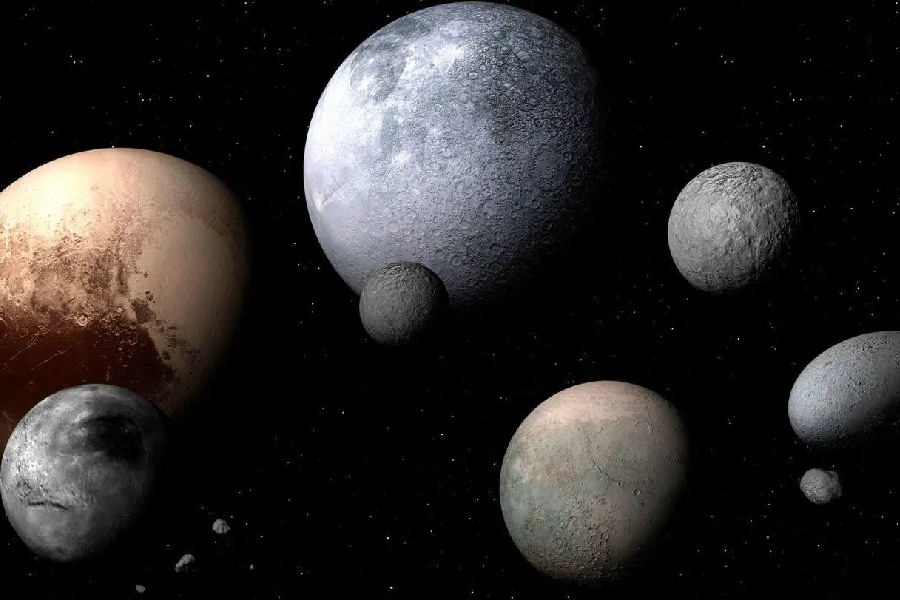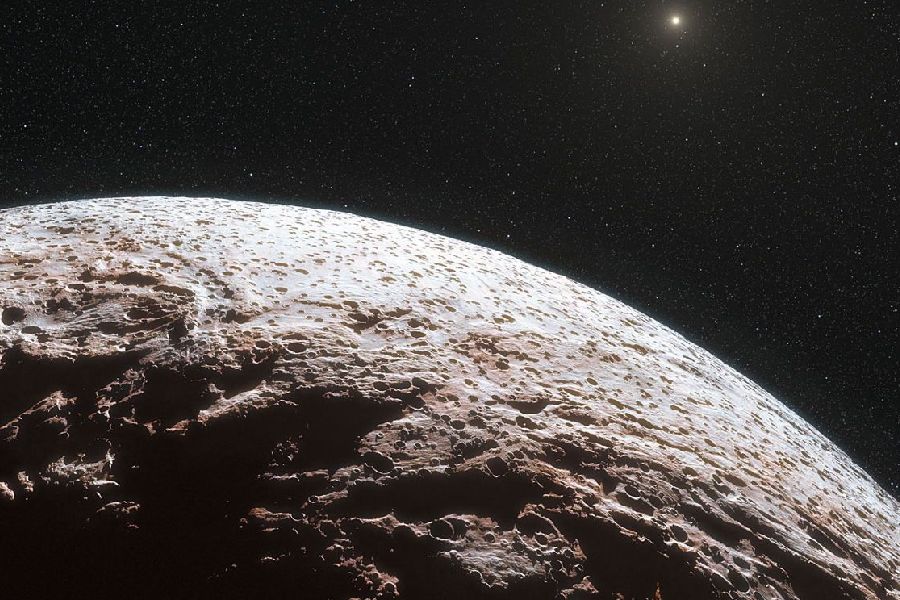Dwarf planets roam the cold outskirts of our Solar System, distant icy worlds harboring unknown ingredients. But what precisely comprises their fragile surfaces? What primordial materials endure on these frozen orbs after long, chaotic migrations? What are dwarf planets made of?
As robotic emissaries begin analyzing dwarf planets like Pluto and Ceres, we slowly unveil pieces of their compositions, textures, and secret transformations.
This article aims to share emerging insights about the elemental makeup and geology of frigid dwarf planets. We’ll compare newly studied worlds like Haumea and Eris to better understand Pluto.
We’ll also discuss how probing the raw materials comprising dwarf planets enables us to trace important clues about early Solar System origins and conditions. Guided by curiosity, we seek to understand the fundamental nature of these celestial entities.
Prepare to be enthralled as we venture into the depths of space. Unraveling the cosmic recipe that gives rise to these captivating and often overlooked members of our Solar System.

What Are Dwarf Planets Made Of?
What are dwarf planets made of? Dwarf planets, like Pluto and Eris, are made up of a mix of different things. They have rocky cores, similar to Earth, surrounded by icy materials like water and methane.
These ices can be found in a frozen state on their surfaces. Unlike big planets, dwarf planets are not massive enough to clear their orbits of other debris, so they’re like cosmic neighbors in a crowded space.
Understanding what dwarf planets are made of helps scientists unlock the secrets of our Solar System and learn more about these small, intriguing celestial bodies.
Materials That Make Up Dwarf Planets
Embarking on the cosmic exploration of dwarf planets unveils a range of diverse materials, each contributing uniquely to the composition of these enigmatic celestial bodies.
Icy bodies
- Frozen essence – Icy bodies, predominantly composed of frozen elements like water and methane, intricately shape the surface features of dwarf planets. Despite their cold nature, these icy constituents play a pivotal role in defining the external appearance of these small wonders.
- Slippery terrain – The characteristics of icy bodies extend beyond their elemental makeup to the creation of slippery terrains on dwarf planets. These frozen landscapes adorned with crystalline formations contribute to the captivating topography of these distant cosmic entities.
- Cosmic chill – Exploring the properties of icy bodies reveals a cosmic chill enveloping dwarf planets. This frigid layer is a cloak of frozen elements. It adds an additional layer of mystery to these distant celestial bodies, emphasizing the delicate balance between extreme cold and the cosmic warmth of the Sun.
Solid bodies
- Rocky foundations – Solid bodies within dwarf planets boast resilient rocky cores akin to our Earth. These foundational rocks provide structural strength, serving as the bedrock for the entire cosmic structure of these celestial wanderers.
- Earthly resemblance – Features and attributes of solid bodies showcase striking similarities to Earth’s composition. These rocky elements not only contribute to the gravitational pull experienced on the surface but also mirror the intricate geological processes that shape terrestrial planets.
- Hidden depths – Beyond the visible surfaces, solid bodies harbor hidden depths. These depths remain shrouded in mystery, and unraveling them is crucial for deepening our understanding of the intricate nature of dwarf planets and their geological intricacies.
Gas giants
- Dwarf planets vs. gas giants – In a nuanced comparison, dwarf planets emerge as smaller celestial entities, distinct from their colossal counterparts – the gas giants. The primary distinction lies in the significant difference in gravitational pull, affecting their ability to clear orbits of debris.
- Size matters – Gas giants, colossal in both size and mass, dominate the outer realms of the Solar System, showcasing their gravitational prowess. In contrast, dwarf planets, with their modest proportions, exist as petite neighbors, each with distinctive characteristics that highlight the rich diversity within our cosmic neighborhood.
- Orbital dynamics – Gas giants, with their expansive orbits and imposing presence, coexist with smaller dwarf planets, creating a delicate dance of celestial bodies. Understanding these complex orbital dynamics sheds light on the nuanced interactions shaping our Solar System and influencing the trajectories of these cosmic entities.
Hydrostatic Equilibrium
The structure of dwarf planets relies on hydrostatic equilibrium – the balance between gravity and internal pressure. This cosmic balance shapes dwarf planets and reveals insights into their geological complexity.
Hydrostatic equilibrium maintains the round structure of these distant worlds. It allows subsurface oceans to persist amidst frozen exteriors, and it influences the way energy moves between liquid mantles and solid crusts within dwarf planets.

Explanation of hydrostatic equilibrium
Balancing forces
At its core, hydrostatic equilibrium is a dance of balance. Gravitational forces relentlessly pull inward, seeking to collapse a celestial body. While internal pressure counters this gravitational pull, pushing outward. This equilibrium state ensures a stable, often spherical shape for dwarf planets.
Counteracting forces
Visualize it as a cosmic tug-of-war: gravitational forces attempt to collapse the celestial body while internal pressure resists this collapse.
The equilibrium sweet spot occurs when these opposing forces find a precise balance. Preventing further deformation and maintaining the overall shape of the dwarf planet.
Spherical symmetry
Under hydrostatic equilibrium’s influence, dwarf planets gravitate toward a spherical form. Gravity pulls evenly from the center, molding icy exteriors and fluid mantles. An equilibrium emerges between gravity’s sculpting force and the planet’s structure – a cosmic collaboration crafting rounded worlds.
On distant icy stages, this symmetry unfolds. Gravity and pressure perform a graceful duet, guiding dwarf planets in a dance toward spherical uniformity – an aesthetic signature of hydrostatic balance.
Importance of hydrostatic equilibrium
- Structural integrity – The gravitational dance with internal pressure ensures the structural integrity of dwarf planets. This delicate equilibrium prevents irregular shapes or structural deformities, contributing significantly to the overall stability of these celestial bodies.
- Size and shape insights – Delving into the nuances of hydrostatic equilibrium provides valuable insights into the size and shape of dwarf planets. This celestial balance act aids scientists in deciphering the gravitational and internal pressure forces shaping these cosmic wanderers.
- Geological implications – Beyond the dance of forces, the importance of hydrostatic equilibrium extends to the geological realm of dwarf planets. The stability provided by this equilibrium influences various geological processes, assisting researchers in interpreting surface features and unraveling the geological history of these celestial bodies.
As scientists scrutinize the dance of hydrostatic equilibrium, they uncover the profound implications that echo through the vast cosmic theater of our Solar System.
Dwarf Planets in the Solar System
There are several confirmed dwarf planets in our Solar System, located primarily in the outer reaches past Neptune. These worlds are smaller than typical planets but still large enough to be rounded under their own gravity.
The first identified dwarf planet was Pluto, reclassified in 2006 when Eris and other small worlds were discovered. Pluto resides within the Kuiper belt and is orbited by large moons like Charon, forming a double dwarf planet system.
Other dwarf planets in the Kuiper belt include Haumea, Makemake, Quaoar, and the possible dwarf planet Sedna. These icy worlds likely contain mixtures of rock and volatile ices like methane and nitrogen.
The dwarf planet Ceres orbits in the asteroid belt between Mars and Jupiter. At almost 620 miles wide, Ceres constitutes over one-third of the belt’s entire mass. The only dwarf planet not beyond Neptune, Ceres shows evidence of subsurface liquid water.
More dwarf planets likely await discovery, perhaps even a proposed “Planet Nine” influencing orbits out beyond Pluto. But most known dwarfs are trans-Neptunian objects, helping reveal Kuiper belt properties and outer Solar System origins. Understanding these frozen, petite planets provides insights into the diversity of worlds in our Sun’s realm.
Ninth planet debate
There is an ongoing debate about the potential existence of an as-yet-unseen “Planet Nine” beyond Neptune. This hypothetical planet is thought to explain the unexpected motions of extreme trans-Neptunian objects. If confirmed to exist, it would reshape theories on the Solar System’s edge.
While some analyses indicate a large perturbing gravitational force very far out, the evidence remains inconclusive. The proposed ninth planet is likely faint, small, and slow-moving if real, making detection very challenging. Ruling it out or validating its presence is crucial for unraveling outer Solar System mysteries.
Conclusion
We have learned that dwarf planets consist of a rugged rocky core surrounded by icy materials, orbiting our Sun in a delicate dance governed by hydrostatic equilibrium. We hope this exploration has finally revealed what are dwarf planets made of – a combination of ice and rock balanced gravitationally into rough spheres.
By surveying their composition and structural dynamics, you now better understand the fundamentals underlying these distant cosmic bodies.
There is still much to learn about the specific origins and evolutionary details of individual dwarf planets in our galactic neighborhood. But armed with the foundation provided in this article, you can approach future discoveries with the core knowledge of what gives these frozen, rounded worlds their essence. Our cosmic horizon grows clearer, one dwarf planet at a time.
